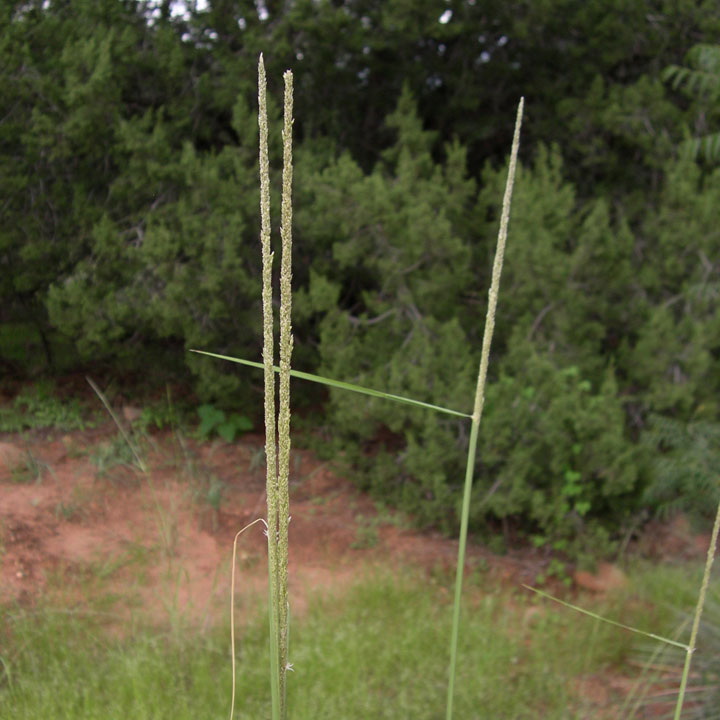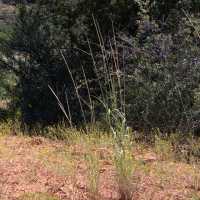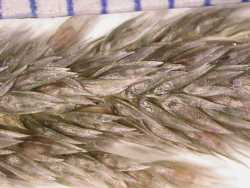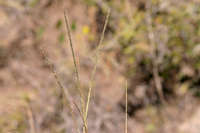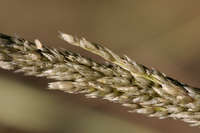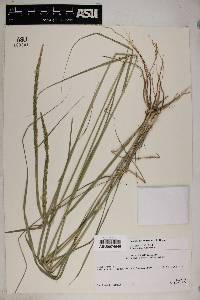|
|
|
|
Family: Poaceae
spike dropseed
[Sporobolus cryptandrus var. strictus Scribn.] |
Plants perennial; cespitose, not rhizomatous. Culms 40-100(120) cm tall, 2-4(5) mm thick near the base. Sheaths rounded below, margins hairy, particularly distally, hairs to 3 mm, apices with conspicuous tufts of hair; ligules 0.4-1 mm; blades (2)4-35 cm long, 3-8 mm wide, flat to involute, glabrous on both surfaces, margins whitish, somewhat scabridulous. Panicles all terminal, (10)15-45(50) cm long, 0.2-0.8(1) cm wide, contracted, spikelike, dense, usually included in the uppermost sheath; lower nodes with 1-2(3) branches; primary branches 0.3-1.5 cm, appressed, spikelet-bearing to the base; secondary branches appressed; pulvini glabrous; pedicels 0.2-2 mm, appressed, scabridulous. Spikelets 1.7-3.2 mm, whitish to plumbeous. Glumes unequal, narrowly lanceolate, membranous, prominently keeled; lower glumes 0.7-1.7 mm, usually 1-veined, acute to acuminate; upper glumes 2-3.2 mm, at least 2/3 as long as the florets; lemmas 2-3.2 mm, linear-lanceolate, membranous, glabrous, acute; paleas 1.8-3 mm, linear-lanceolate, membranous, glabrous; anthers 3, 0.3-0.5 mm, light yellowish. Fruits 0.8-1.2 mm, ellipsoid, laterally flattened, light brownish or translucent. 2n = 36. Sporobolus contractus grows in dry to moist, sandy soils, at elevations from 300-2300 m. It is found occasionally in salt-desert scrub, desert grasslands, and pinyon-juniper woodlands. Its range extends to the states of Baja California and Sonora in Mexico. FNA 2003, Gould 1980 Common Name: spike dropseed Duration: Perennial Nativity: Native Lifeform: Graminoid General: Tufted perennial grass, stems 40-120 cm tall and 2-4 mm in diameter at the base, in small clusters to large clumps. Vegetative: Sheaths rounded, open, glabrous with one pubescent margin and a conspicuous tuft of hair at the apex; blades 2-5 mm wide, 10-30 cm long, flat or involute, glabrous, tapering to a slender tip; ligule a dense fringe of short hairs 0.5-1 mm. Inflorescence: Dense, contracted, spikelike terminal panicle, 1 cm or less thick and 15-50 cm long; basal portion of spike and sometimes entire spike remain enclosed in upper leaf sheath; spikelets light brownish or lead-colored, 2-3 mm long; glumes thin, membranous, unequal, first usually about half as long as second; second equaling the lemma or slightly shorter; caryopsis 1 mm in length, broad and flattened. Ecology: Found in dry, open, sandy or rocky slopes and washes, and frequent along roads from 2,500-6,500 ft (762-1981 m); flowers August-October. Distribution: sw US from CA, NV east to TX and OK; south to c MEX. Notes: Sporobolus species have single seeded spikelets with unequal glumes, no awns, and most often small seeds which readily fall after maturing, hence the common name "dropseed.- This species is distinguished by being a perennial with tightly contracted inflorescences, 0.2-1 cm wide, and stems to 1.2 m tall. Similar to S. cryptandrus but that species usually has an open panicle by the time it matures; Gould claims that the two species intergrade. Also similar to S. giganteus but that species is larger, up to 2 m tall and the panicles are wider (1-4 cm wide). Ethnobotany: Seeds used as food by various Native American groups; ground and mixed into a porridge, combined with with corn meal, or used for flour. Synonyms: Sporobolus cryptandrus var. strictus Editor: SBuckley 2010, FSCoburn 2014, AHazelton 2015 Etymology: Sporobolus is Greek for "seed-caster" while contractus means contracted. |


